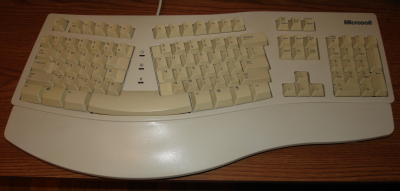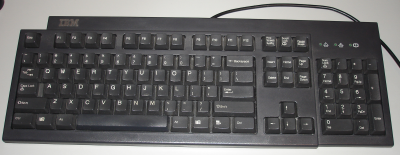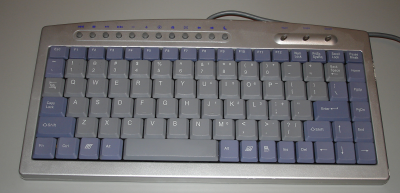I spend a lot of time in front of a keyboard. It is one the negatives that come along with having your work and play intersect. As a result I have had some small RSI problems over the years. It has never gotten to the debilitating stage but it is has definitely caused me to go watch TV when I’d rather be working on the computer (I hate watching TV).
In an attempt to reduce the RSI problems I have tried a quite a few different keyboards. For many years I used my trusty MS Natural Keyboard. This is an original MS full size natural. I bought it as part of the first computer I paid for by myself, sometime around 1995. It still works perfectly. The layout is better than most keyboards but the keys are pretty stiff, this may be age related.

I also have an really nice keyboard that came with an IBM iSeries server. It is a traditionally shaped keyboard but the keys are really nice. Unfortunately, using this keyboard didn’t do much good (or bad) for my RSI problems.

I have also tried a small laptop size keyboard. This was probably the worst of the many keyboards I have tried to use. I don’t know what I was thinking.

There are many more less memorable keyboards that I have tried which were also of little use in reducing the RSI pain.
Not only have I tried many different keyboards I have tried adding a keyboard tray with an attached mouse tray to get the proper posture and positioning. I think this helped but it did not solve the problem.
During the time I have been experimenting with other keyboards I knew about Kinesis keyboards. There are probably very few computer geeks who haven’t ooogled over a Kinesis contoured keyboard at some point. These keyboards look cool and are designed to be ergonomic. Unfortunately, they also cost a small fortune.
A few months ago, with the inspiration of my friend Andrew, I finally broke down and bought a Kinesis contoured keyboard. Honestly, this is the best ~$350 I have ever spent. After using this keyboard for a few months most of my day-to-day RSI symptoms are gone. It only took a few days to get reasonably fast at typing on the Kinesis but there are still moments when my fingers instinctively go to the wrong spot (especially after a day at work with a normal keyboard). The fact that the Kinesis lacks a keypad is also a nice plus; this keyboard actually sits centered in the keyboard tray and if you use it on a desk surface it doesn’t force your mouse to be far off to the right. The feel of the keys is also the best of any keyboard I have tried. I am reasonably confident that the combination of this keyboard and the keyboard tray is responsible for the improvement in my RSI symptoms because it only takes a few hours at a normal keyboard before the symptoms to return.
So why am I writing this little story? There is a lesson here. For several years I was too cheap to buy the proper equipment that may have helped my RSI problems and I paid for it a little each day with unnecessary pain. Don’t be like me. If you have RSI problems get yourself a keyboard designed for your hands not ease of manufacture.
I’m probably buying a second one to have at work.
